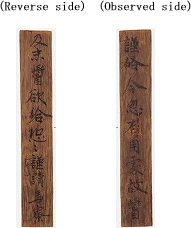
NABUNKEN NEWS vol.45
Wooden Tablet World of the Fujiwara Palace ─ Wooden tablets unearthed around the east-facing north gate ─
Wooden tablets are precious historical materials that convey the real statements of ancient people who lived in various periods. The Fujiwara Palace wooden tablets enable us to vividly envisage the profiles of the court nobles/officials who lived in the era of reform of the pre and post Taiho Code enforcement.
The wooden tablets unearthed at the Fujiwara Palace site to date number in excess of 16,000 pieces, a quarter of which (approx. 4,000 pieces) were excavated from the inner and outer moats situated on the periphery of the east-facing north gate (ie., “Yamabe Gate”). The contents of the discovered wooden tablets can be divided into two groups; One group consists of matters related to the Imperial Household Ministry, the Ministry of Central Affairs, and their subordinate agencies; and the other consists of tags attached to such foodstuffs as seafood, mainly for the emperor and court nobles.
Please refer to the wooden tablets below, which are representative tablets selected from the planning exhibition “Buried Profiles of Court Nobles - Wooden tablets found around the east-facing north gate of the Fujiwara Palace”, held from April 7 to May 6, 2012, in commemoration of the 60th anniversary of the founding of the Nara National Research Institute for Cultural Properties as well as the holiday opening (incl. Saturdays and Sundays) of the “Fujiwara Palace Site Data Exhibition Hall.
(KUWATA Kuniya, Department of Imperial Palace Sites Investigations)
The photos below are all full-scale. The sizes of the wooden tablets with fractures are parenthesized.
 Wooden tablet in which the name of a gate of the Fujiwara Palace is inscribed The wooden tablet below reads “Tajihi Gate, Yamabe Gate”. The Tajihi gate corresponds to the north-facing east gate, and the Yamabe gate corresponds to the east-facing north gate of the Fujiwara Palace. The area of the Fujiwara Palace was about one kilometer square, with 3 gates per side (12 gates in total). Each gate was named for the clans of that time period such as the Tajihi clan and Yamabe clan. This is presumably because those clans were assigned to guard their corresponding gate. Size: (180) millimeters long, (12) millimeters wide, 4 millimeters thick |
 Corresponding wooden tablet requesting soy sauce and soybean paste This wooden tablet says something like “Please supply soy sauce and soybean paste, we need them right now”. The words formed with the last character on the observed side and the first three characters on the reverse side read “醤” (soy sauce) “及” (and) “末醤” (soybean paste)”. However, “醤” and “末醤” are ancient seasonings; i.e., the primitive form of the present soy sauce and soybean paste. The request addresser is the “Meryo (lit. the Bureau of Horses; the office in charge of horse breeding /breaking), which is represented by the last two characters on the reverse side (馬寮). Meanwhile, the request addressee should probably be the “Daizenshiki” (lit. the Office of the Palace Table; or “Zenshiki”, if it was written prior to the Taiho Code enforcement). Despite saying “right now”, all the characters are written accurately with no appearance of haste. Size: 189 millimeters long, 32 millimeters wide, 4 millimeters thick |
